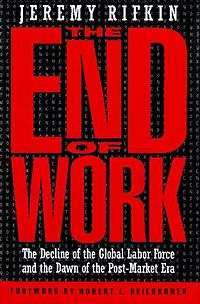The End of Work
|
Front Cover | |
| Author | Jeremy Rifkin |
|---|---|
| Country | United States |
| Language | English |
| Subject | Socio-economics |
| Publisher | Putnam Publishing Group |
Publication date | 1995 |
| Media type | Hardcover |
| Pages | 400 |
| ISBN | 1-58542-313-0 |
| OCLC | 865211968 |
The End of Work: The Decline of the Global Labor Force and the Dawn of the Post-Market Era is a non-fiction book by American economist Jeremy Rifkin, published in 1995 by Putnam Publishing Group.[1]
Synopsis
In 1995, Rifkin contended that worldwide unemployment would increase as information technology eliminated tens of millions of jobs in the manufacturing, agricultural and service sectors. He predicted devastating impact of automation on blue-collar, retail and wholesale employees. While a small elite of corporate managers and knowledge workers would reap the benefits of the high-tech world economy, the American middle class would continue to shrink and the workplace become ever more stressful.
As the market economy and public sector decline, Rifkin predicted the growth of a third sector—voluntary and community-based service organizations—that would create new jobs with government support to rebuild decaying neighborhoods and provide social services. To finance this enterprise, he advocated scaling down the military budget, enacting a value added tax on nonessential goods and services and redirecting federal and state funds to provide a "social wage" in lieu of welfare payments to third-sector workers.[1]
Critical reception
A number of economists and sociologists have been critical of Jeremy Rifkin for being one of the major contributors to the "end of work" discourse and literature of the 1990s. Autonomist political philosopher George Caffentzis concluded that Rifkin's argument is flawed because it is based on a technological determinism that does not take into account the dynamics of employment and technological change in the capitalist era.[2]
A major theme of the The End of Work is that productivity would lead to the destruction of jobs; however, the book appeared when productivity growth had been in a slowdown since the early 1970s. Because the widespread use of computers in the 1980s and early 1990s did not live up to the high expectations for productivity growth, this was called the productivity paradox. Strong productivity growth finally appeared in the late 1990s and lasted a few years, then slowed down again. The productivity slowdown is still being debated.[3] Strong growth but without absorbing large numbers of unemployed people is called a jobless recovery. Historically, innovation that obsoletes existing jobs and technologies has not created permanent unemployment, but has instead opened jobs in new industries and moved jobs from agriculture to industry and the service sector. This process is known as creative destruction.
See also
- Basic income guarantee
- Automation
- Luddite fallacy
- Other books by Rifkin:
- The European Dream (2004)
- The Empathic Civilization (2010)
- The Third Industrial Revolution (2011)
Notes
References
- Caffentzis, George (1998) The End of Work or the Renaissance of Slavery? A Critique of Rifkin and Negri, presented at the Globalization from Below Conference at Duke University, February 6, 1998. Also published in Bonefeld, Werner, ed. (2003). Revolutionary Writing: Common Sense Essays in Post-Political Politics. Autonomedia. ISBN 1-57027-133-X.
Negri and Rifkin are major participants in the "end of work" discourse of the 1990s [...] The formal logic of the argument appears impeccable, but are its empirical premises and theoretical presuppositions correct? I argue that they are not, for Rifkin's technological determinism does not take into account the dynamics of employment and technological change in the capitalist era. [...] The "end of work" literature of the 1990s, therefore, is not only theoretically and empirically disconfirmed.
Further reading
- Ayres, Robert U. (1998). Turning Point: an End to the Growth Paradigm. London: Earthscan Publications. ISBN 9781853834394.
- Bjork, Gordon J. (1999). The Way It Worked and Why It Won’t: Structural Change and the Slowdown of U.S. Economic Growth. Westport, CT; London: Praeger. ISBN 0-275-96532-5.
- "Race Against The Machine". by Erik Brynjolfsson and Andrew McAfee
- Paepke, C. Owen (1992). The Evolution of Progress: The End of Economic Growth and the Beginning of Human Transformation. New York, Toronto: Random House. ISBN 0-679-41582-3.
- "I Lost My Job". documentary by New Future Media
- "Zeitgeist Moving Forward". documentary
External links
- Jeremy Rifkin: The Foundation of Economic Trends: Books: The End of Work
- The End of Work or the Renaissance of Slavery? A Critique of Rifkin and Negri
- What's Wrong with This Picture? A critique of Jeremy Rifikin's book The End of Work by Bob Black
